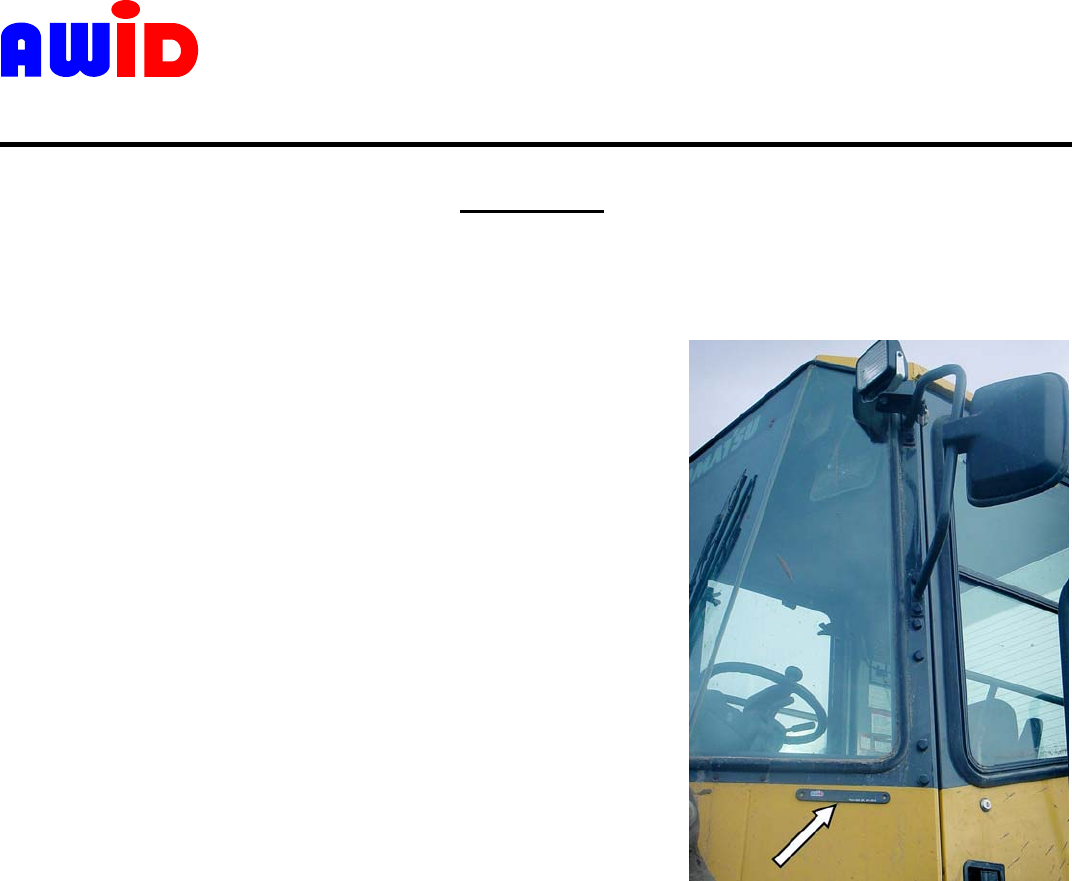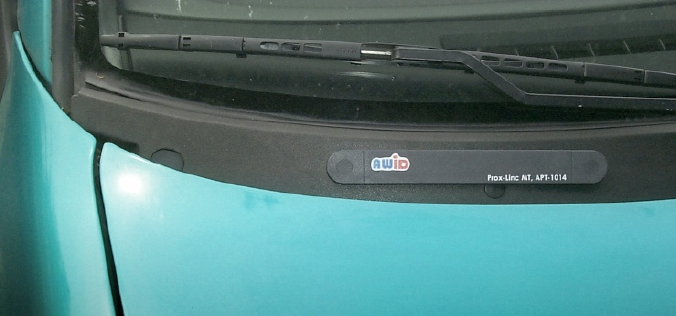Applied Wireless Identifications Group R26EA011 LR-911 and 2010AR RFID Reader User Manual Tag MT Mounting Recommendations
Applied Wireless Identifications Group Inc. LR-911 and 2010AR RFID Reader Tag MT Mounting Recommendations
Contents
- 1. GMSW Holding Instructions
- 2. LR911 Installation Instructions
- 3. Users Manual
- 4. Tag MT Mounting Recommendations
- 5. Tag WS Mounting Recommendations
Tag MT Mounting Recommendations

APPLIED WIRELESS ID Applied Wireless Identifications Group, Inc.
382 Route 59 - Section 292, Monsey NY 10952 • Tel: 845-369-8800 • Fax: 845-369-1195
Instructions
Vehicle Mounting Recommendations for Metal-Mount Tags (MT)
The MT tag is an alternative to the WS windshield tag that is commonly used in automated vehicle identification (AVI)
applications. The MT tag offers flexible features with advantages in many uses. The MT tag may be –
Placed inside or outside the vehicle.
Fastened to a surface or supported by itself.
Attached to metal and still get full rated read range.
Fastened to a surface temporarily (using Velcro, for example).
Fastened to a surface permanently (using added silicone sealant,
or with double-sided adhesive foam, or by screws).
Held at one end between thumb and fingertip during reading.
Moved between vehicles when administrative rules allow.
Typical locations on the MT tag on the vehicle are –
Top of the front bumper.
Between bars in the grill.
Side of the hood.
Side or top of the cowling.
Near windshield wipers.
Side door panel.
Edge or center of the roof.
Quarter panel behind a truck door.
Dashboard or sun visor facing the reader through the windshield.
Permanent attachment outside the vehicle:
1. Select a tag location that can be used by all or most of the vehicles.
2. Select a flat surface where the MT tag is facing the front surface of the reader, and parallel to it, when the tag
is at the reading distance from the reader (typically between 5 feet and 8 feet).
3. Test-read the tag before final attachment.
4. Use screws through the holes at the ends of the tag. Screws may be nylon, round-head, with head inside recess.
5. If screws are not allowed, peel the paper label from the back of the tag, and apply silicone sealant behind the tag.
6. Apply a small bead of sealant at the edges where the tag meets the vehicle surface. This seals out moisture.
Temporary attachment outside the vehicle:
1. Select a tag location that can be used by all or most of the vehicles.
2. Select a flat surface where the MT tag is facing the front surface of the reader, and parallel to it, when the tag
is at the reading distance from the reader (typically between 5 feet and 8 feet).
3. Use silicone sealant behind the tag, or use double-sided adhesive tape.
Attachment inside the vehicle:
1. Apply pieces of hook-and-loop fasteners (for example, Velcro), behind the MT tag and on the dashboard.
2. Position the tag so that it faces the reader. The tag may be rotated so that a long edge of the tag faces the reader.
Quick access inside the vehicle:
1. Lay the MT tag on the dashboard inside the windshield, facing the reader. Use masking tape to hold position.
(continued)

For best results:
The MT tag may not be carried inside clothing or any container. It must have line-of-sight to the front of the reader.
The MT tag may be supported by a surface of any material -- metal, plastic, wood, etc. -- or supported in air.
The MT tag is ideally attached to a surface, but it may be held by the fingers if the ta
g
is squeezed between
the thumb and forefingers at the end of the tag, at either screw hole.
The front surface of the tag should be facing the reader.
The front surface of the MT tag should be parallel to the reader's front face at the point where the tag is read
by the reader. If the tag must be tilted relative to the reader, have the long edge of the tag closest to the reader,
not the curved end of the tag.
The MT tag may be attached to its supporting surface (a) by inserting screws or pins or wires (non-metal is best;
screw head inside the recess) throu
g
h the screw holes at the two ends of the ta
g
, or (b) b
y
appl
y
in
g
an
adhesive sealant, like silicone seal, or a foam adhesive strip, between the tag (after the peelable label is removed)
and the mounting surface.
The tag must remain flat when it is attached to the surface. The tag must not be forced into a curve by tightening
the screws or by pressing the tag against the surface.
If the supporting surface is curved, use varying thickness of adhesive sealant or foam behind the tag to allow the tag
to remain perfectly flat.
Applying a small bead of sealant around the edges of the tag, where it lies on the supporting surface, will keep
moisture out of the space behind the tag and extend the life of the adhesive.
Do not let the metal foil behind the tag's plastic body separate from the tag. If it does come loose, immediately
reapply the foil to the tag. Use care to prevent bubbles or creases when the foil is pressed back into place. If any
separation of foil from plastic remains, that tag should be used only where moisture cannot reach the tag.
After the MT tag has been attached to the surface and tested, snap the screw-hole plugs into place at both ends
of the tag, for good appearance and security.
Moisture on MT tags:
Accumulated snow on the front surface of the MT tag may have a strong effect on the tag’s read range. A thin film
from condensation on the front and sides of the tag has a weak effect on performance.
Moisture that accumulates behind the tag, between the foil on the back of the tag and the surface to which the tag
is attached has no effect.
If the foil separates from the rounded ends of the tag near the screw-hole, moisture between the foil and the plastic
body of the tag has no effect.
If the foil separates from the center of the tag's plastic body, between the screw-holes, the tag's performance will be
affected, causing considerable change in the read range because of the high dielectric constant of water compared
with the tag's material. Use sealant at the edges to keep moisture from the back of the tag.
L.H.H. Revd. 10 Mar ‘06